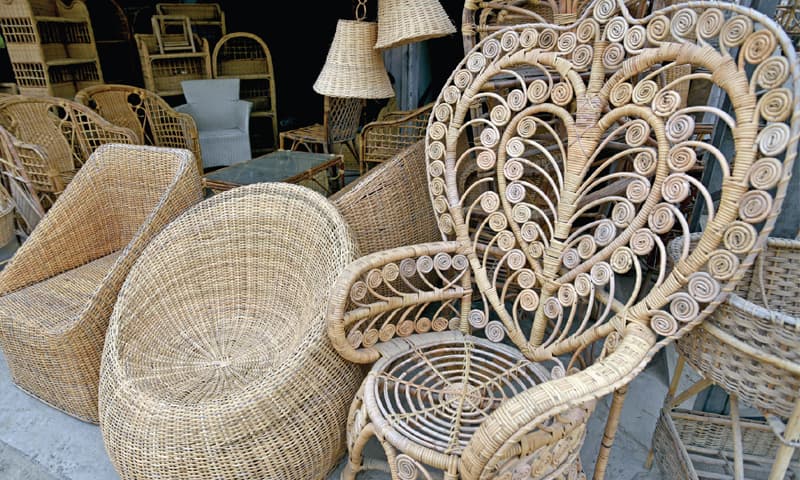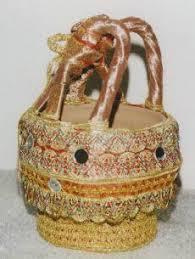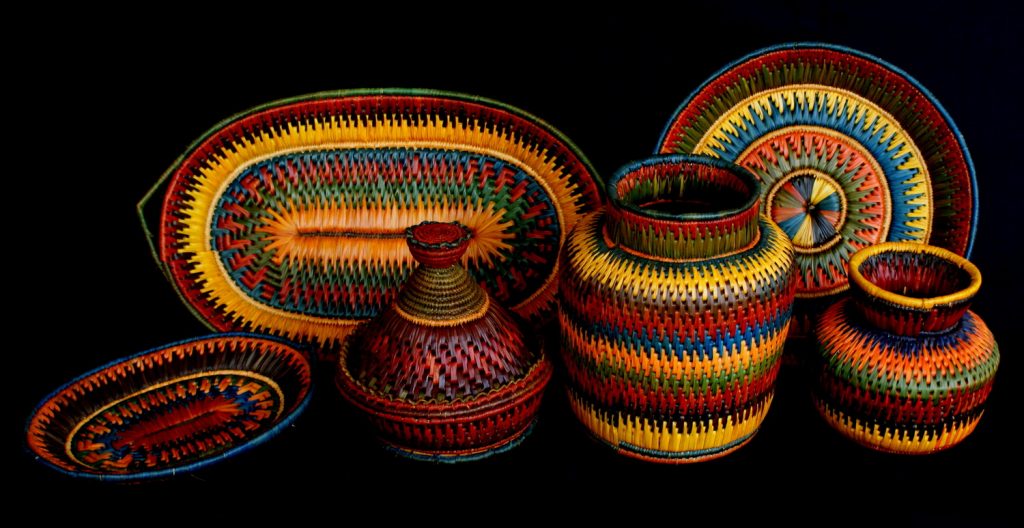Basketry: An Age Old Tradition
Throughout the ages one finds basketry as a widely used skill in every human culture. However the age of this craft cannot be ascertained because the items could not be preserved as they were made of natural materials. The oldest known baskets date back to 10,000 to 12,000 years.
Basketry in Pakistan
The tradition of weaving baskets and other such items is very much practiced in Pakistan today. This craft that has not only been passed down from generation to generation but our artisans are also constantly innovating to meet consumer demands. Thereby the quality and finesse are a testament of the level of craftsmanship. Different techniques are employed, which vary according to the raw materials available in that area. Both men and women are engaged in the craft of basketry which can be a full time job or a secondary one
Basketry in Pakistan: The Basic Method
A simple style of weaving is to take some split rushes. They are used as weft to cross the warp threads, first going under a given number of warps and then going over the same number. By varying the number of warp threads in the two stages of crossing, some weavers inter-twine geometric patterns. A wooden frame is used to set the weft. The sides are woven to form firm edges.
There are four types of basketry:
- Coiled b) Plaited c) Twining d) Wicker and Splint
Although all these are used in Pakistan, the most popular form of basketry is coiled, irrespective of the material being used. The coil is looped around a central core and built up spirally. The coils are then sewed together by wrapping palm leaves or straw around them.
Basketry in Pakistan: The Materials Used
Following are the different natural materials which are used to make the different items that we find in the rural and urban markets:
Cane
This is a very popular material. Cane is used to make chairs, chicks, cots, flower vases, picnic baskets, shelves, sofas, swings, suitcases, tables and wall scrolls etc. The cane is heated and shaped. Then the items are put together by nails, while the joints are bound together with softer cane strips. They are often painted and varnished to give them a richer color and shine. And split cane is used to make baskets, fans and plaited mats.
The cane is heated and shaped. Then the items are put together by nails, while the joints are bound together with softer cane strips. They are often painted and varnished to give them a richer color and shine. And split cane is used to make baskets, fans and plaited mats.

Mulberry Tree and Cotton Plant Stem
Large baskets are made from tree branches and cotton plant stem. They are used for hauling heavy loads over long distances such as bricks and sand by construction workers. While shops display fruit and vegetables in them as it seems rather attractive.
The strongest are mulberry tree branches. These make the core structure of ‘Khawa’. This is a coned shaped basket made of a sturdy wooden frame interwoven with alternating stripes of black and white goat hair. It is used by Kalash women to carry their children or goods.

And the thinner twigs are used for delicate and elaborate designs. These are woven in geometric patterns and decorated with beads, frills and tin foils. A fine example is the Kashmiri Kangri (baskets woven around clay fire pots called ‘kondul’ in which the charcoal is kept). These are used even today to keep the rooms warm, and can also be kept under blankets and shawls.

Rushes
These grow plentiful along the banks of rivers. In the past they were use to build cottages in the plains or desert areas. Today they are commonly employed in making bedding, carpet or dining mats and runners. Coiled rushes are used to make thick door or room mats. These can easily withstand sun and rain.
Reeds
The thick reeds are twined to make chairs and stools. The body consists of double rows of twined reeds, while the seats and edges are fastened with chord. Wealthy people may use leather or deer skin for sides and edges. They are also used to make chicks/blinds for verandahs and windows. These are quite useful in keeping rooms cool during the summers. While thin reeds make lovely baskets, boxes and toys.
Raffia
Also found down the river banks are ‘Moonj’ (raffia). Outer stalks are sun-dried and then flattened into a thin thread. This is used in beds, cots and stools. In the northern areas large net baskets are made of it to carry goods on animals. Sandals and beach slippers were once very popular and were readily available in Peshawar.
Date Palm Leaf
This is coiled and plaited to make baskets and chatais. Usually they are woven in chequered pattern which is made by dying palm leaves black or pink. Split palm leaves are used to make hand fans. In Sindh and Baluchistan they are heavily decorated by beads, frills, mirrors and have embroidered designs as well. They are often used as wall décor too.

Dera Ghazi Khan is famous for its light prayer caps. Making of coiled palm ropes and netting them into sacks is practiced widely. For this the craftsmen of Dera Ismail Khan and Peshawar have great distinction.
One of the most attractive items made of Date Palm is the bread basket. It is a flat plate with lifted edges known as ‘chaingar’.

More detailed are baskets with lids used for storing. Smaller models in Sindh are known as ‘Dabki’ and in Punjab and KPK as ‘Chabi’. Sindhi’s adorn Dabkis with beads, feathers, frills and mirrors.

And in KPK they are adorned with geometric shapes. While Uch Shariff and several villages in Multan make charming designs of ‘Chhabi’.
Mazri
This is a dwarf Palm plant abundantly growing in Baluchistan, which it exports to other parts of Pakistan. As a result it is famous for producing items such as baskets, brooms, caps, mats, ropes etc. While coiled and plaited objects in Kurram Agency are known for their lovely patterns.
Both Date Palm and Mazri are used in Southern Punjab to make very pretty Saraiki baskets which are made in colors of the ‘rainbow’.

Wheat Straw
This has a natural sheen which is quite attractive, but often designs in different colors are woven into surface of the object for a nicer look. Dried wheat stems are stripped for the reed and fiber. It can be plaited or wrapped around a nucleus of grass to make bags, baskets and table mats. In Rawalpindi as well as Murree women create a large assortment of items applying various techniques. One that is commonly used is to do appliqué work in floral shapes using cloth, foam or plastic.
Basketry in Pakistan: An Everlasting Craft
So amidst the changing trends, basketry will always have important place in our culture. And why shouldn’t it as we have lovely and colorful items that make a worthy addition to our households. These days sending gifts in baskets are quite the rage as well. Furthermore many independent entrepreneurs are selling items online giving our local artists a platform they did not have before!